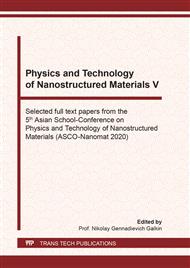[1]
B.H. Verbeek, J.H. Mydosh, Spin glass freezing above the ferromagnetic percolation limit in AuFe alloys, J. Phys. F: Metal Phys. 8 (1978) 109-112.
DOI: 10.1088/0305-4608/8/5/002
Google Scholar
[2]
A. P. Murani, Ferromagnet or spin glass? Magnetic ordering in Au-Fe alloys, J. Phys. F: Metal Phys. 4 (1974) 757-766.
DOI: 10.1088/0305-4608/4/5/017
Google Scholar
[3]
A. Mookerjee, S.B. Roy, Magnetic behaviour of spin-glass alloys beyond the percolation concentration, J. Phys. F: Metal Phys. 13 (1983) 1945-1954.
DOI: 10.1088/0305-4608/13/9/018
Google Scholar
[4]
B. H. Verbeek, G. J. Nieuwenhuys, H. Stocker J. A. Mydosh, Evidence for a Ferromagnet-Spin-Glass Transition in PdFeMn, Phys. Rev. Let. 40 (1978) 586-589.
DOI: 10.1103/physrevlett.40.586
Google Scholar
[5]
H. Maletta, W. Felsch, Magnetic correlations in EuxSr1−xS and the ferromagnet-spin glass transition, Phys. B Cond. Mat. 37 (1980) 55–64.
DOI: 10.1007/bf01325504
Google Scholar
[6]
C. A. F. Vaz, J. A. C. Bland and G. Lauhoff, Magnetism in ultrathin film structures, Rep. Prog. Phys.71 (2008) 78.
DOI: 10.1088/0034-4885/71/5/056501
Google Scholar
[7]
R. Folk, Yu. Golovach and T. Yavorsky, Critical values of a three-dimensional slightly diluted frozen Ising model, UFN 173 (2003) 175-200.
Google Scholar
[8]
H.-O. Heuer, Monte Carlo simulation of disordered 2-dimensional Ising systems, EPL 16 (1991) 503-508.
DOI: 10.1209/0295-5075/16/5/016
Google Scholar
[9]
A. K. Murtazaev, A. B. Babaev and G. Ja. Aznaurova, Investigation of the effect of frozen non-magnetic impurities phase transitions in the three-dimensional Potts model, Phys. of the Solid State, 50 (2008) 703-708.
DOI: 10.1134/s1063783408040227
Google Scholar
[10]
U. Wolff, Collective Monte Carlo Updating for Spin Systems, Phys. Let. 62 (1989) 361-364.
DOI: 10.1103/physrevlett.62.361
Google Scholar
[11]
K. Binder, Critical properties from Monte Carlo coarse graining and renormalization, Phys. Rev. Lett. 47 (1981) 693-696.
DOI: 10.1103/physrevlett.47.693
Google Scholar
[12]
K. Binder, D. Hermann, Monte Carlo Simulation in Statistical Physics, Springer Science & Business Media, (2013).
Google Scholar
[13]
D. Stauffer, Scaling theory of percolation clusters, Phys. Rep. 54 (1979) 1-74.
Google Scholar
[14]
H.J. Hermann, D Stauffer, Corrections to scaling and finite size effects, Phys. Let. A 100 (1984) 366-369.
DOI: 10.1016/0375-9601(84)91087-9
Google Scholar
[15]
P.V. Moskalev, Estimates of the threshold and power of percolation clusters on square lattices with a (1, π) neighborhood, Computer Research and Modeling 5 (2014) 405–414.
DOI: 10.20537/2076-7633-2014-6-3-405-414
Google Scholar
[16]
D. I. Iudin, Fractals: from simple to complex, Novgorod, (2012).
Google Scholar


